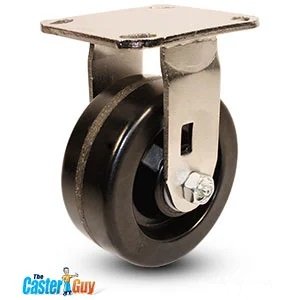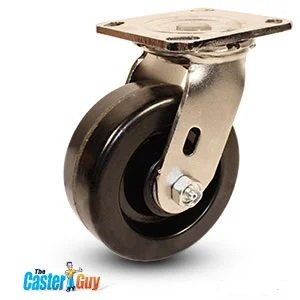Welcome to The Caster Guy! In this guide, we will explore the fundamental differences between fixed and swivel casters. Understanding these differences will help you make the right choice for your specific needs, ensuring optimal performance and functionality for your equipment.
What Are Casters?
Casters are wheeled devices typically mounted to the bottom of a larger object, allowing it to be easily moved. They are commonly used in various applications, from industrial machinery to office furniture, and come in different types to cater to specific requirements. The two primary types of casters are fixed casters and swivel casters.
Fixed Casters

Fixed Caster
Definition
Fixed casters, also known as rigid casters, have a wheel mounted in a fixed frame. This means that the wheel can only roll forward and backward in a straight line and cannot swivel or turn.
Features
- Straight-line movement: Fixed casters provide a stable, straightforward movement path, making them ideal for applications where precise directional control is required.
- Sturdiness: Due to their rigid frame, fixed casters are generally more robust and can carry heavier loads compared to swivel casters.
- Durability: The simpler construction of fixed casters often translates to increased durability and longer service life.
Applications
Fixed casters are commonly used in applications where controlled, straight-line movement is crucial. Some typical examples include:
- Manufacturing and assembly lines
- Warehouse carts and dollies
- Industrial equipment and machinery
- Hospital beds and medical equipment
Swivel Casters

Swivel Caster
Definition
Swivel casters are designed with a wheel mounted to a fork that can rotate 360 degrees. This allows the wheel to pivot and move in any direction, providing greater maneuverability.
Features
- Maneuverability: Swivel casters offer exceptional maneuverability, making it easy to change direction and navigate tight spaces.
- Flexibility: The ability to pivot in any direction allows for smooth and versatile movement, ideal for applications requiring frequent directional changes.
- Ease of use: Swivel casters reduce the effort needed to move and position objects, enhancing overall efficiency.
Applications
Swivel casters are suitable for applications where flexibility and ease of movement are essential. Common examples include:
- Office chairs and furniture
- Retail displays and fixtures
- Medical carts and equipment
- Food service carts and trolleys
Comparing Fixed and Swivel Casters
Stability vs. Maneuverability
The primary difference between fixed and swivel casters lies in the trade-off between stability and maneuverability. Fixed casters provide excellent stability and straight-line control, making them ideal for heavy-duty applications where precise movement is required. In contrast, swivel casters offer superior maneuverability, allowing for easy directional changes and navigation in confined spaces.
Load Capacity
Fixed casters generally have a higher load capacity compared to swivel casters due to their rigid construction. This makes them suitable for transporting heavy loads over long distances. Swivel casters, while versatile, may have lower load capacities and are better suited for lighter loads or applications requiring frequent directional changes.
Durability
Fixed casters tend to be more durable because they have fewer moving parts. This simplicity often results in a longer lifespan and reduced maintenance. Swivel casters, with their rotating mechanism, may require more frequent maintenance to ensure smooth operation.
Cost
The cost of fixed and swivel casters can vary depending on the materials, design, and load capacity. Generally, fixed casters are less expensive due to their simpler construction. Swivel casters, offering greater flexibility and maneuverability, may be more costly, especially for high-quality or heavy-duty models.
Choosing the Right Caster
Selecting the appropriate caster for your application involves considering several factors:
- Movement requirements: Determine whether you need straight-line stability or flexible maneuverability.
- Load capacity: Assess the weight of the objects you need to move and choose a caster that can support the load.
- Environment: Consider the environment in which the casters will be used, such as indoor or outdoor, and the type of flooring.
- Durability: Evaluate the durability and maintenance requirements of the caster based on the frequency of use and operational conditions.
- Cost: Factor in your budget and the overall cost of ownership, including potential maintenance and replacement costs.
Conclusion
Understanding the differences between fixed and swivel casters is essential for selecting the right type for your needs. Fixed casters provide stability and straight-line movement, making them ideal for heavy-duty applications. Swivel casters offer superior maneuverability, perfect for environments requiring frequent directional changes.
At The Caster Guy, we offer a wide range of high-quality fixed and swivel casters to suit various applications. Whether you need durable fixed casters for industrial use or versatile swivel casters for office furniture, we have the perfect solution for you. Browse our catalog today and find the ideal casters for your needs!

